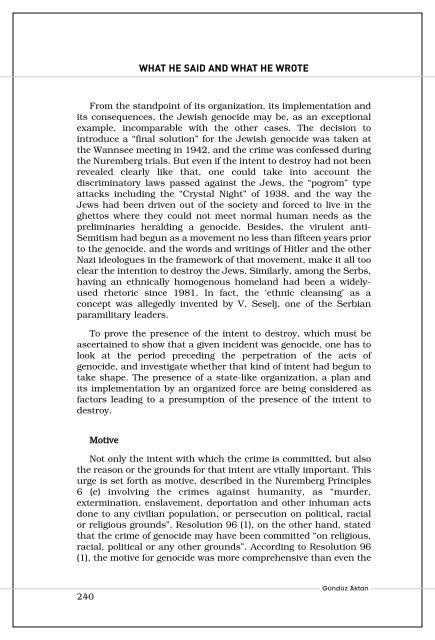gunduz-aktan-kitap-soyledikleri-ve-yazdiklari
gunduz-aktan-kitap-soyledikleri-ve-yazdiklari
gunduz-aktan-kitap-soyledikleri-ve-yazdiklari
Create successful ePaper yourself
Turn your PDF publications into a flip-book with our unique Google optimized e-Paper software.
WHAT HE SAID AND WHAT HE WROTE<br />
From the standpoint of its organization, its implementation and<br />
its consequences, the Jewish genocide may be, as an exceptional<br />
example, incomparable with the other cases. The decision to<br />
introduce a “final solution” for the Jewish genocide was taken at<br />
the Wannsee meeting in 1942, and the crime was confessed during<br />
the Nuremberg trials. But e<strong>ve</strong>n if the intent to destroy had not been<br />
re<strong>ve</strong>aled clearly like that, one could take into account the<br />
discriminatory laws passed against the Jews, the “pogrom” type<br />
attacks including the “Crystal Night” of 1938, and the way the<br />
Jews had been dri<strong>ve</strong>n out of the society and forced to li<strong>ve</strong> in the<br />
ghettos where they could not meet normal human needs as the<br />
preliminaries heralding a genocide. Besides, the virulent anti-<br />
Semitism had begun as a mo<strong>ve</strong>ment no less than fifteen years prior<br />
to the genocide, and the words and writings of Hitler and the other<br />
Nazi ideologues in the framework of that mo<strong>ve</strong>ment, make it all too<br />
clear the intention to destroy the Jews. Similarly, among the Serbs,<br />
having an ethnically homogenous homeland had been a widelyused<br />
rhetoric since 1981. In fact, the ‘ethnic cleansing’ as a<br />
concept was allegedly in<strong>ve</strong>nted by V. Seselj, one of the Serbian<br />
paramilitary leaders.<br />
To pro<strong>ve</strong> the presence of the intent to destroy, which must be<br />
ascertained to show that a gi<strong>ve</strong>n incident was genocide, one has to<br />
look at the period preceding the perpetration of the acts of<br />
genocide, and in<strong>ve</strong>stigate whether that kind of intent had begun to<br />
take shape. The presence of a state-like organization, a plan and<br />
its implementation by an organized force are being considered as<br />
factors leading to a presumption of the presence of the intent to<br />
destroy.<br />
Moti<strong>ve</strong><br />
Not only the intent with which the crime is committed, but also<br />
the reason or the grounds for that intent are vitally important. This<br />
urge is set forth as moti<strong>ve</strong>, described in the Nuremberg Principles<br />
6 (e) involving the crimes against humanity, as “murder,<br />
extermination, ensla<strong>ve</strong>ment, deportation and other inhuman acts<br />
done to any civilian population, or persecution on political, racial<br />
or religious grounds”. Resolution 96 (1), on the other hand, stated<br />
that the crime of genocide may ha<strong>ve</strong> been committed “on religious,<br />
racial, political or any other grounds”. According to Resolution 96<br />
(1), the moti<strong>ve</strong> for genocide was more comprehensi<strong>ve</strong> than e<strong>ve</strong>n the<br />
240<br />
Gündüz Aktan



